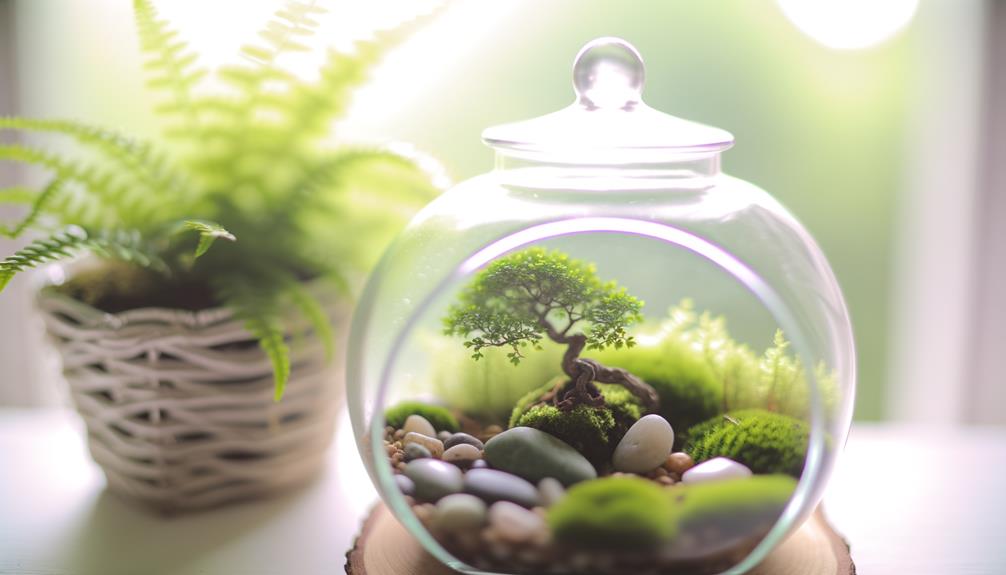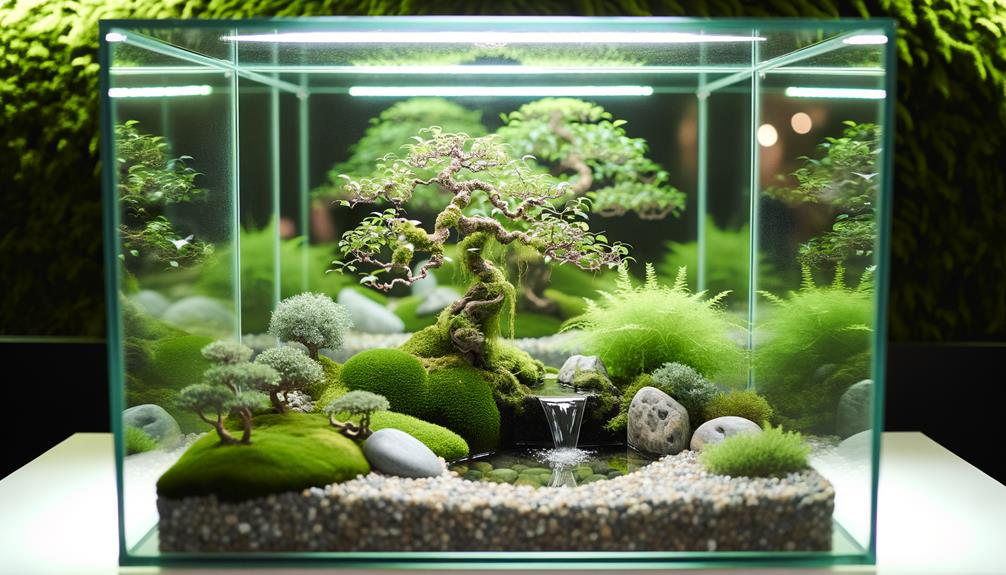How You Put Your Bonsai in a Terrarium for Successful Growth
Placing a bonsai in a terrarium is possible with careful attention to environmental conditions. Tropical species like Ficus and Schefflera thrive due to their preference for high humidity.
Proper microclimate management includes regulated ventilation, controlled humidity using hygrometers, and suitable substrates for drainage. LED grow lights providing 12-16 hours of full-spectrum light are essential to mimic natural sunlight.
Continuous monitoring of microclimatic variables guarantees the bonsai's health, while meticulous pruning and controlled watering prevent fungal growth and root rot. Mastering these elements will enable the flourishing of bonsai within terrariums, ensuring optimal growth and longevity.
Explore further for detailed information.

Key Takeaways
- Bonsai can thrive in terrariums with controlled humidity and proper ventilation.
- Choose tropical bonsai species like Ficus or Schefflera for optimal growth in high-humidity environments.
- Ensure the terrarium provides indirect sunlight or full-spectrum LED lighting for photosynthesis.
- Regularly prune and monitor humidity levels to maintain bonsai health and prevent disease.
- Select a terrarium size that accommodates the bonsai's mature dimensions to prevent overcrowding.
Understanding Bonsai Needs

Understanding bonsai needs involves a thorough knowledge of their specific requirements for light, humidity, soil composition, and pruning techniques to promote ideal growth and health. Bonsai trees require precise light conditions, typically preferring indirect sunlight to prevent leaf scorch.
Humidity levels must be carefully regulated to prevent desiccation or fungal growth. The substrate for bonsai must be a well-draining mix, often comprising akadama, pumice, and lava rock, ensuring best root aeration and nutrient uptake.
Pruning is essential to maintaining the miniature aesthetic, necessitating both structural and maintenance trimming. Structural pruning shapes the tree, while maintenance pruning controls new growth. Understanding these nuanced requirements is necessary for cultivating a thriving bonsai, particularly when considering the constraints of a terrarium environment.
Terrarium Environment Basics
Creating an ideal terrarium environment for a bonsai tree requires a thorough understanding of microclimatic variables, such as temperature control, ventilation, and humidity regulation, to mimic the specific conditions needed for the tree's health and growth.
Temperature must be monitored diligently, maintaining a stable range that aligns with the species' natural habitat.
Ventilation is essential to prevent fungal growth and guarantee gas exchange, often facilitated through adjustable vents or periodic opening of the terrarium.
Humidity levels should be carefully controlled, using hygrometers and misting systems to replicate the necessary moisture conditions.
Additionally, appropriate substrate selection and drainage are crucial to avoid root rot, ensuring the bonsai's root system remains healthy and well-aerated.
Suitable Bonsai Species

When choosing bonsai species for terrarium cultivation, tropical varieties such as Ficus and Schefflera are preferred due to their ability to thrive in high humidity and stable temperatures.
The size and growth rate of the species must be carefully considered to maintain the bonsai within the limited space of the terrarium.
Additionally, the plant's specific humidity and light needs must align with the microenvironment provided by the terrarium to support healthy and flourishing growth.
Tropical Bonsai Varieties
Selecting appropriate tropical bonsai varieties for a terrarium involves considering species such as Ficus benjamina, Schefflera arboricola, and Serissa foetida, which thrive in humid, enclosed environments. These species exhibit traits conducive to terrarium conditions, such as tolerance to low light and high humidity. Ficus benjamina, commonly known as the Weeping Fig, is lauded for its adaptability and resilience. Schefflera arboricola, or Dwarf Umbrella Tree, is favored for its robust growth and minimal maintenance requirements. Serissa foetida, often referred to as Tree of a Thousand Stars, is prized for its small, delicate flowers.
| Species | Common Name | Key Characteristics |
|---|---|---|
| Ficus benjamina | Weeping Fig | Adaptable, resilient |
| Schefflera arboricola | Dwarf Umbrella Tree | Robust growth, minimal maintenance |
| Serissa foetida | Tree of a Thousand Stars | Small flowers, delicate foliage |
Size and Growth Rate
Understanding the size and growth rate of suitable bonsai species is vital for maintaining a balanced and aesthetically pleasing terrarium environment. Selection criteria should focus on species that exhibit compact growth, slow to moderate growth rates, and adaptability to confined spaces.
Key considerations include:
- Miniature Varieties: Species like Ficus microcarpa and Serissa japonica remain small and manageable within terrarium confines.
- Growth Rate: Opt for slow-growing species to minimize frequent pruning; Juniperus procumbens and Cotoneaster horizontalis are ideal.
- Root System: Shallow-rooted species such as Ulmus parvifolia reduce the risk of root-bound conditions.
Proper selection guarantees that the bonsai does not outgrow the terrarium, which is essential for long-term maintenance and visual harmony.
Humidity and Light Needs
Proper moisture and light levels are crucial factors for sustaining the health and vigor of bonsai species within a terrarium setting. Tropical and subtropical species, such as Ficus benjamina and Schefflera arboricola, thrive in high moisture environments, typically between 50-80%.
Conversely, temperate species like Juniperus procumbens may suffer from excessive dampness. Light requirements must also be carefully managed; full-spectrum LED lights replicating natural sunlight are recommended to ensure adequate photosynthesis. Photosynthetically active radiation (PAR) values should be monitored to avoid photoinhibition or insufficient light.
Integrating hygrometers and light meters facilitates precise control of these conditions, fostering an ideal microclimate for bonsai maintenance. Selection of suitable species is crucial for successful terrarium cultivation.
Choosing the Right Terrarium
To guarantee ideal growth conditions for a bonsai within a terrarium, it is crucial to take into account the terrarium's size, material, and ventilation features.
The size of the terrarium should provide ample space for root expansion and canopy growth without causing constraint.
The material, preferably glass or high-quality acrylic, ensures sufficient light penetration and durability.
Ventilation is critical to prevent humidity buildup and mold proliferation.
Consider the following factors:
- Size: Ensure the terrarium can accommodate the bonsai's mature dimensions.
- Material: Choose materials that allow maximum light transmission and are resistant to scratches.
- Ventilation: Incorporate adjustable vents or openings to regulate airflow and humidity levels.
These considerations will help create an optimal microenvironment for your bonsai.
Creating Proper Drainage

Securing suitable drainage is the next critical step, as it prevents root rot and promotes healthy root development within the terrarium environment. Sufficient drainage is achieved through the strategic layering of substrates. Begin with a base layer of coarse materials such as gravel or pebbles to facilitate water flow. Above this, add a layer of activated charcoal to filter impurities and prevent fungal growth. Finally, top it with a well-draining soil mix suited for bonsai trees. This structured approach secures excess water is efficiently channeled away from the roots.
| Layer | Function |
|---|---|
| Gravel/Pebbles | Facilitates water flow |
| Activated Charcoal | Filters impurities, prevents fungi |
| Well-Draining Soil | Supports root health |
Managing Humidity Levels
Effective management of humidity levels in a bonsai terrarium is crucial for both plant health and preventing fungal growth.
Monitoring moisture levels using hygrometers ensures that the internal environment remains within ideal parameters.
Additionally, incorporating adequate ventilation mechanisms facilitates proper airflow, thereby mitigating excessive humidity accumulation.
Monitoring Moisture Levels
Maintaining the best humidity levels is crucial for the health and growth of a bonsai tree within a terrarium environment. Proper moisture management involves regular monitoring to ensure optimal conditions.
Key strategies include:
- Moisture Sensors: Utilize advanced sensors to measure soil moisture content accurately, providing real-time data for timely adjustments.
- Hygrometers: Install hygrometers to continuously monitor ambient humidity levels, ensuring they remain within the ideal range for bonsai health.
- Watering Schedule: Develop a precise watering regimen based on the specific needs of the bonsai species and environmental conditions within the terrarium.
Ventilation for Airflow
To prevent excessive moisture and promote healthy air circulation, integrating a well-designed ventilation system is crucial for a bonsai terrarium. Adequate airflow is vital to reduce risks linked with high humidity levels, such as mold growth and root decay. Employing adjustable vents or small fans can maintain consistent air exchange, sustaining optimal oxygen and carbon dioxide levels.
Additionally, passive ventilation methods, like using perforated lids or strategically placed mesh panels, can support natural convective currents. Monitoring relative humidity with a hygrometer allows for precise adjustments, ensuring the microclimate remains within the ideal range of 40-60%.
Proper ventilation not only supports the bonsai's physiological processes but also prevents the spread of pathogens, thereby enhancing overall plant health.
Lighting Considerations

Proper lighting is essential for the best growth and health of a bonsai within a terrarium environment. Bonsai trees require specific light spectra and intensities to thrive, which can be challenging to replicate in enclosed spaces.
To achieve the best lighting conditions, consider the following:
- Light Source: Use full-spectrum LED grow lights as they closely mimic natural sunlight, providing the necessary wavelengths for photosynthesis.
- Duration: Maintain a photoperiod of 12-16 hours of light daily to simulate natural daylight cycles, promoting robust growth and circadian rhythm.
- Intensity: Ensure light intensity is adequate, typically around 2000-3000 lumens, to penetrate the terrarium glass and reach the bonsai effectively.
Inadequate lighting can lead to etiolation, reduced vigor, and poor overall health.
Maintenance and Care Tips
Regular monitoring and precise adjustments to humidity, pruning, and watering regimes are essential for guaranteeing the best health and longevity of a bonsai within a terrarium environment.
Humidity levels should be meticulously controlled, ideally maintained between 50-70%, to prevent fungal growth and dehydration.
Pruning is critical; it should be performed with sterilized tools to prevent disease, maintaining the desired shape and promoting airflow.
Watering requires a balance; overwatering can lead to root rot, while underwatering can cause desiccation. Use a moisture meter to determine when watering is necessary.
Additionally, periodic fertilization with a balanced, slow-release fertilizer will provide essential nutrients.
Regular inspection for pests and diseases ensures early intervention, maintaining the bonsai's health.
Conclusion
Incorporating bonsai into terrariums necessitates a thorough understanding of both bonsai horticulture and terrarium ecosystems. Essential factors include selecting appropriate species, ensuring adequate drainage, regulating humidity, and optimizing lighting conditions.
Through meticulous attention to these parameters, one can create a thriving miniature landscape that harmonizes the intricate requirements of bonsai with the controlled environment of a terrarium.
This synthesis of art and science highlights the delicate balance necessary to sustain such a unique botanical endeavor.






